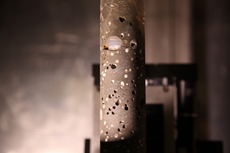Carbon dioxide tucked into basalt converts to rock
19 Nov 2016
In fairy tales, magical spells can turn people and things to stone. In a desert in southeastern Washington state, it's a chemical reaction that converts carbon dioxide into stone.
 | |
| The white areas within the dark basalt rock core sample show where the CO2 has reacted with minerals in the basalt and converted into a carbonate mineral similar to limestone |
Researchers at the Department of Energy's Pacific Northwest National Laboratory (PNNL) injected CO2 into basalt lava flows a half mile underground near Wallula, Washington.
In just two years, it had converted to a carbonate mineral or solid rock according to results published on Friday in the journal Environmental Science & Technology Letters.
To prove the process operates the same way deep underground, they injected nearly 1,000 tons of CO2in a field study. The results can help inform the discussion about whether the greenhouse gas can be safely and permanently stored in ancient basalt flows.
In November, the Paris Climate Agreement goes into effect to reduce global carbon emissions. To achieve the set targets, experts say capturing and storing carbon must be part of the solution. Several projects throughout the world are trying to make that happen.
Now, a study on one of those endeavours, reported in the ACS journal Environmental Science & Technology Letters, has found that within two years, carbon dioxide (CO2) injected into basalt transformed into solid rock.
Lab studies on basalt have shown that the rock, which formed from lava millions of years ago and is found throughout the world, can rapidly convert CO2 into stable carbonate minerals.
 | |
| Conventional wisdom said it would take thousands of years for this to occur. PNNL researchers thought differently after their lab tests demonstrated that the unique geochemical nature of basalts quickly react with CO2 to form carbonate minerals - something akin to limestone. |
One field project in Iceland injected CO2 pre-dissolved in water into a basalt formation, where it was successfully stored. And starting in 2009, researchers with Pacific Northwest National Laboratory and the Montana-based Big Sky Carbon Sequestration Partnership undertook a pilot project in eastern Washington to inject 1,000 tons of pressurized liquid CO2 into a basalt formation.
After drilling a well in the Columbia River Basalt formation and testing its properties, the team injected CO2 into it in 2013.
Core samples were extracted from the well two years later, and Pete McGrail and colleagues confirmed that the CO2 had indeed converted into the carbonate mineral ankerite, as the lab experiments had predicted. And because basalts are widely found in North America and throughout the world, the researchers suggest that the formations could help permanently sequester carbon on a large scale.






.webp)















